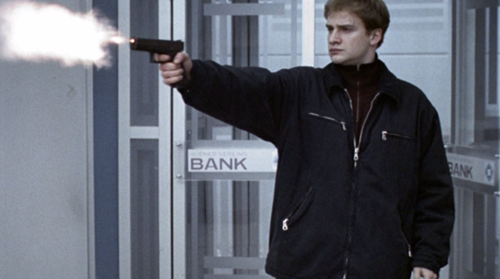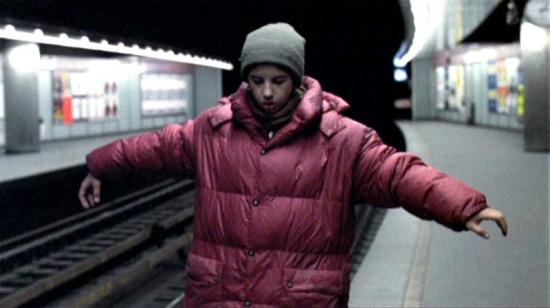 Televisual Absorption
Televisual Absorption
Michael Haneke's 71 Fragments
published in Film Comment Vol.42. No.5, New York 2006Michael Haneke is not alone when he comments that film ‘comes to life with sound’. Has there been an auteur who has not realised as much when – after labouring over shot selection interred in the edit suite – felt revived by the mere alignment of the simplest acoustical occurrence to their silent moving imagery? On the one hand, this is testament to how ‘auteurism’ is forensically cited via the a-sonic discourses of literature, theatre and photography, to which most auteurs align themselves. Like the deaf, the critical diaspora which appends the Auteur Theory to the spread of global internationalist cinema ‘signs’ these assertions rather than ‘voices’ them. On the other hand, a problematic is exposed: what exactly might ‘auteur sound’ be?
While the notion of mise-en-scene at its most rudimentary spotlights theatre direction as the core vein of ‘director cinema’, auteurist film sound for the bulk of the 20th century mostly conforms to the European notion of ‘direct sound’: visuals are directed, while sounds are simply direct. Critics and theorists have long smothered the ontological investigation of so-called ‘direct sound’ with poor metaphorical assignations of ‘truth’ and ‘honesty’. To wit: the classical auteurist film will ‘sound’ unaffected and unstylised. Poor audiovisual perceptiveness accounts for the unchallenged predominance of the soundtrack as a pseudo-mystical occurrence of natural events in front of the ‘recording angel’ – microphones as they are more commonly known.
Haneke’s cinema is rooted in the ‘direct sound’ ethos, yet its convolution within his philosophical, dramatic and cinematic matrix gives rise to perceptual consideration beyond the impasse that ‘direct sound’ holds for the cinematically-deaf. 71 Fragments: of a Chronology of Chance (1994) antagonises ‘direct sound’. While retaining the presence of unaltered acoustica, ‘sono-theatrical’ devices are employed to accentuate sound not as given, but as recorded.
The film’s severe reduction of dialogue aids this greatly. In place of authorial voice, spatial environments actively ‘sound’ a character’s situation. Indeed, the soundtrack forwards a rendering of how the world is indifferent to its inhabitation by humans. Throughout 71 Fragments, characters are acoustically framed by a mix of omniphonic and telescopic sound: irrespective of visual cropping, we audit the totality of their space – shunting trams, droning freeways, congested arcades, emptied parklands. Characters’ silence dramatically connotes Haneke’s often-noted ‘glacial isolation’. Yet their mute status more precisely contextualises them in a televisual space whose audiovisual imbalance impregnates the characters and their situations with an emotional disconnectivity from their living breathing surroundings.
Concordant with Goddard’s appropriation of Eisensteinian montage as son-image, Haneke utilises edits to punctuate acts of placement and removal. The episodic black-outs throughout 71 Fragments are more sonically felt than they are optically gauged. They gulp silence like one’s final breath before going under; their negation of sight and sound replicates the traumatization of sensing through sound that one is in a void. These halting black-outs sever the fulsome soundtrack from its detailing of urban acousmatic density. Ultimately, they forecast an overwhelming numbness of mortality as we witness in cinematic silence the guard’s soundless seeping body. His pooling blood reconfigures him as a humoral hour-glass voiding its own contents: all that passes as he passes away is time itself.
Haneke’s chilled distillation of a contemporary urban modernism is best expressed through the soundtrack. If his settings were lush and pastoral, audiences would drink till drunk on warbling birdsong, babbling brooks and the glorious cries of airborne eagles. No – they sound as grubby as the grimy clothing of 71 Fragments’ Romanian street kid. In fact all sound is backgrounded not for scopic depth, but in acknowledgement of mediarised sound’s televisual absorption. Much of Haneke’s films – 71 Fragments emblematically so – sound like a TV playing in another room. All space – architectural, technological, personal, public – is flattened through an embrace of how lives are enured within the psycho-acoustic vectoring of broadcast transmission. Such is the stage for his characters’ fractured dialogue with each other.
The sedimentary power of Haneke’s cinema lies in its televisual priming over which literary depth is layered. 71 Fragments audiovisually appears cinematic, but its unfiltered broadband capture of humanity impassively exploits the film medium’s late-millennial aura of heightened filamentous activity. Far from being a mere ‘signing’ of how cold and clinical the mediarised world has come, it is a quietening documentation of sizable moral proportion: the ‘nobodies’ cartographically and chronographically strewn across 71 Fragments are ‘recorded angels’, rendered as signs of life through the act of their encoding by camera and microphone alike. Haneke’s ‘unblinking’ gaze on life’s harshness simply acknowledges that our ears do not blink.
Text © Philip Brophy 2006. Images © Kino Video

